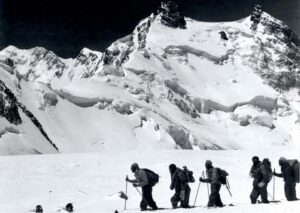Heavy duty, long-lasting, technologically advanced and adaptable to most environments, space pens are the ideal writing utensils whether in space or on Earth. Astronauts have trusted them since the 1960s. I’m sure we can too.
Ballpoint pens, a first step
Ballpoint pens emerged in the 1880s from a painstaking process of trial and error. Early ballpoints frequently leaked, skipped, or clogged. But after World War II, businesses took a renewed interest, and a sort of race to design and produce better pens began.
Hungarian-Argentinian inventor Laszlo Biro designed the modern ballpoint. This mighty pen took the world by storm. Later, U.S. companies like Eversharp, Reynolds, and Paper Mate emerged.
The idea of a “space pen” came later, thanks to Paul C Fisher. After World War II, Fisher found himself in need of a new job after. He had a lucrative career in the ball-bearing business, which supplied bomber planes with precision bearings. When the war ended, he put his inventive mind to something less deadly.
However, Fisher did not want to mimic the other pen companies. After navigating his way around the industry for a few years, he founded the Fisher Pen Company in 1948, working extensively on his own special ink and design.

Paul C. Fisher. Photo: Wikipedia Commons
Write in space, or underwater
He took the ballpoint pen and kicked the mechanics up a notch, hoping to correct the current model’s limitations. He patented his iconic AG7 in the mid-1960s, it was the first-ever ballpoint that did not rely on gravity to release ink. You could write upside down and at any angle. It contained special ink created by Fisher himself, could withstand temperatures up to 121°C, could write underwater, was leakproof, and boasted a shelf life of 100 years. Fisher did not receive outside funding for its research and development, he paid $1 million out of his pocket.
However, perhaps the most impressive innovation was his Universal Refill Cartridge. Fisher developed a special thixotropic visco-elastic ink which, in the cartridge at rest, bears the consistency of toothpaste. When released by pressure applied to the tungsten carbide ballpoint, this toothpaste-like ink transforms into smooth, sticky liquid ink. This has an additional advantage too, it prevents leakage.
The cartridge also contains pressurized nitrogen gas to keep the ink flowing when activated by the ballpoint. The pen depends on this gas rather than gravity. Each pen can write three times longer than your average ballpoint, with tests showing that it writes for up to 49km.
The pen is not made of plastic but rather of brass and steel with chrome platings. These materials help it withstand an array of temperatures and extreme conditions. While it is heavier than your usual ballpoint, it is significantly more sturdy.
The term “space pen” came from its involvement in NASA’s Apollo missions. Astronauts previously used wooden or mechanical pencils to make important calculations, keep records, and take notes. However, the graphite in pencils proved too dangerous in space. Graphite combusts and conducts electricity, plus the wood is flammable.

An astronaut on a spacewalk. Photo: Vadim Sadovski/Shutterstock
NASA made an initial order for 400 pens. The Russians soon placed their own order. To this day, the AG7 bears the nickname “Astronaut Pen” because of this. In 1968, the pen first traveled to space with Apollo 7.
The design and mechanics of the pen have not changed in decades. Even today, missions to the International Space Station carry at least one pen. Despite the emergence of computers and other devices, the pen is not out of fashion on Earth yet either.






